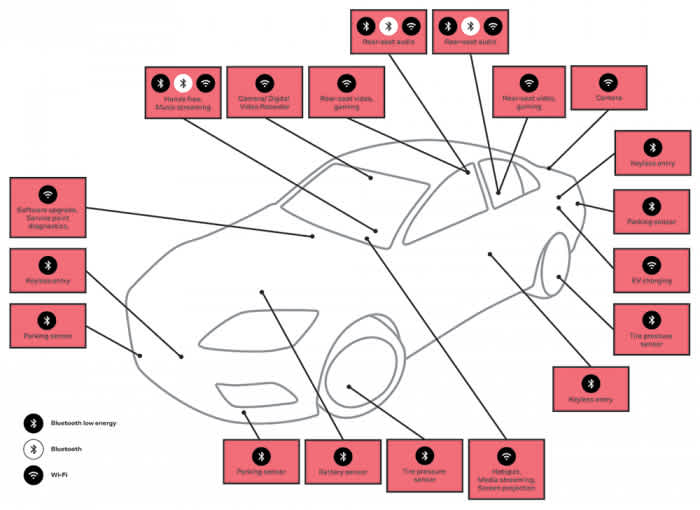Auto Makers Double Down on Wi-Fi
Many new features in cars start as expensive options for luxury editions and evolve into standard features for all models. This certainly has been true with Wi-Fi. According to Car and Driver magazine, “Wi-Fi access has become a major selling point for buyers, especially for those who feel cut off from the world without Internet access. In fact, having a Wi-Fi hot spot is typically an expectation when considering a new vehicle.”
From its start as a simple way for our passengers to surf the Internet and watch movies while we’re driving, Wi-Fi’s utility has increased significantly, in part due to new features available in Wi-Fi 6. This article will trace how Wi-Fi is being used in cars and its evolution from an expensive option to an essential feature.
Why Wi-Fi?
Most smartphones can serve as hotspots, and we all have smartphones, so why do cars need Wi-Fi? Several reasons.
Honda - As any parent can tell you, keeping everyone connected is a big part of modern family happiness. With our new...4G LTE Wi-Fi, the new Odyssey is all about keeping everyone connected and comfortable.”
First, Wi-Fi installed in your car doesn’t consume your phone’s battery nor your mobile data plan. Also, as we’ll discuss later, Wi-Fi installed in your car enables features that you can’t get with phone-based Wi-Fi. Moreover, it guarantees you autonomy and a secured and reliable connection all the time: there might be public hotspots, but you don’t need to depend on them anymore - plus, Wi-Fi connection in your own car is generally safer than a Starbucks Wi-Fi!
It Started with Entertainment
When Wi-Fi first appeared in cars, passenger entertainment was a huge driver and differentiator. For example, when Honda added Wi-Fi to its 2018 Odyssey minivan, it enabled streaming video to its ceiling-mounted rear entertainment system. Regarding its utility, a Honda executive commented, “As any parent can tell you, keeping everyone connected is a big part of modern family happiness. With our new...4G LTE Wi-Fi, the new Odyssey is all about keeping everyone connected and comfortable.”
This functionality and sentiment have been echoed by many other carmakers. Here’s a blurb from Jaguar's website. “Wi-Fi Hotspot is all about keeping you connected. It allows you and your passengers to connect to the internet via a powerful in-car 4G hotspot. This means that up to eight devices can be connected to keep in touch with work, life, and entertainment while on the move.” Cadillac's website prompts potential buyers to “take ownership to the next level. Cadillac Connected Services helps make ownership more enjoyable and simplifies your life while on the go.”
Mercedes Benz - “One of the greatest technological innovations to be added to Mercedes-Benz vehicles in recent years is the ability to connect to a Wi-Fi hotspot in your vehicle.
Mercedes Benz gushes, “One of the greatest technological innovations to be added to Mercedes-Benz vehicles in recent years is the ability to connect to a Wi-Fi hotspot in your vehicle. This has a couple of benefits. For one, you can avoid overage charges with your cellphone carrier, which can just be annoying. And two, it allows devices like tablets or laptops that may not have 4G capability to easily connect to the Internet with a connection that is secure and fast.”
BMW touts the productivity-related benefits of Wi-Fi, “WiFi in the car...could soon revolutionize our workplace. Collaborative tools enable location-independent cooperative work, easy communication, and secure exchange of documents. Provided one has a stable internet connection, work can be done at home, in the park, in the café or on the beach, as well as on the train or in the car...For new car buyers, WiFi is increasingly becoming a key factor when it comes to making a purchase decision, if not a basic requirement.”
Regarding FordPass Connect, Ford’s website explains, “Up to 10 devices can connect at once, and you can use FordPass to keep track of your Wi-Fi data usage. You can access the hotspot up to 50 feet outside the vehicle. Now you can stay connected, even as you roam the highways.”
Ford - “Now you can stay connected, even as you roam the highways.”
Going Beyond Entertainment and Connectivity
For perspective, understand that although Wi-Fi’s range has extended significantly over previous generations, it’s essentially a local technology. Within a car, Wi-Fi (and often Bluetooth) is used to allow dozens of sensors and other devices to communicate with each other and the car’s CPU. When data is interchanged with services outside the car, this can be done via Wi-Fi if the external service is local--like a car on a dealer’s lot--or via cellular if more remote. In this fashion, Wi-Fi and cellular work together to keep your car connected.
Figure 1. Internal connectivity use cases for the connected car (Image credit EDN).
This technology collaboration enables features like location sharing, driving history, and crash response. Tesla goes far beyond this with remote diagnostics and over-the-air (OTA) software updates that can eliminate repair trips to the dealership. As described on Tesla’s website, “If your car requires attention, Tesla mobile technicians can complete most repairs wherever you park. If they can’t fix your issue on the spot, they can often identify and pre-diagnose repairs for faster service when you arrive at a Tesla Service Center.”
Where is all this going? The website Electrek, which tracks the transition from gas-powered cars to electric, predicts that “in a not-so-distant self-driving future, I can see your Tesla sending you a message asking if you need your car for a certain window of time, and if you don’t, it will drive by itself to the service center to get an issue fixed.” As traditional carmakers computerize more and more functions within their vehicles and launch new electric vehicles, many are also offering OTA updates. You can learn which companies offer OTA updates and how they work In this article, also on electrek.
The Promise of Wi-Fi 6
Meanwhile continued R&D investments by Wi-Fi contributors deliver new features that will enable newer versions of Wi-Fi, like Wi-Fi 6, to more efficiently serve in automobile-related applications. As detailed in EDN, “Wi-Fi 6 is expected to become the de-facto wireless interface for fully-connected cars. The most significant improvement over its predecessor is increased spectral efficiency, delivering an up-to-fourfold increase in channel capacity. This will either allow it to serve more clients per access point or enable new high-bandwidth use cases, for example streaming ultra-high-resolution video. Wi-Fi 6’s flexibility makes it better adapted to serve clients using smaller chunks of data, without reserving unnecessary overhead.
These improvements are elaborated upon in NXP’s article, 6 Reasons Why Automotive OEMs Are Upgrading to Wi-Fi 6, which lists less congestion, longer range, lower power, faster speeds, upload performance, and consumer satisfaction as the six reasons.
Figure 2. As predicted by BMW, autonomous driving will only make integrated Wi-Fi even more important to the automobile (Image credit - BMW).
The benefits that Wi-Fi delivers will only increase as autonomous driving becomes a reality. As summarized by BMW, “Permanently integrated WiFi, in particular, illustrates a change that vehicles are currently undergoing. Whereas we are currently using cars purely for locomotion, in the future autonomous driving will open up new possibilities: From the mobile office and entertainment to simple connectivity – WiFi in the car is one of the first steps towards achieving these goals.”
BMW - “From the mobile office and entertainment to simple connectivity – WiFi in the car is one of the first steps towards achieving these goals.”
Clearly, automakers are all in when it comes to Wi-Fi. For you, as consumers, this means ever-increasing convenience and safety.
Funding Innovation
Wi-Fi innovations come from multiple companies that invest hundreds of millions annually in R&D. Some recoup their investment largely via product sales, while others are research organizations that fund R&D with royalties from the companies that manufacture and sell products that utilize their technologies. As a patent pool administrator, Sisvel helps form and manage patent pools that provide efficient access to the technologies created by their patent owners.
A patent pool allows, by signing a single contract, to deliver access to multiple patented technologies, reducing overall administrative and licensing costs and accelerating time to market. Royalties paid by these licensees enable additional R&D to ensure that Wi-Fi and other technologies continue to meet and anticipate the future needs of current and new users.
Think about this innovation cycle the next time your passengers surf the Internet or watch high-quality movies while you’re driving, or you get an email from your car telling you that your engine is overheating and needs checking. Without the advancements funded by royalties, none of this would be happening.
Head image credit IEEE SA


